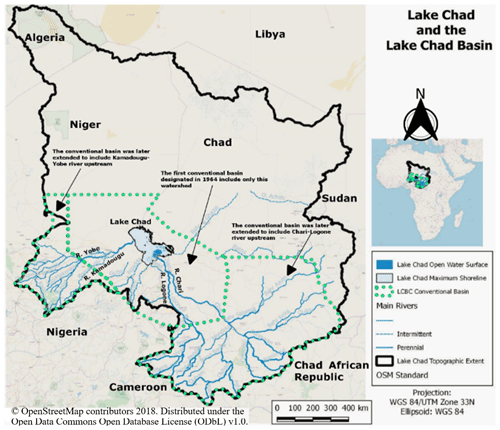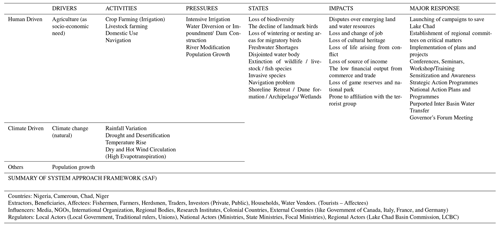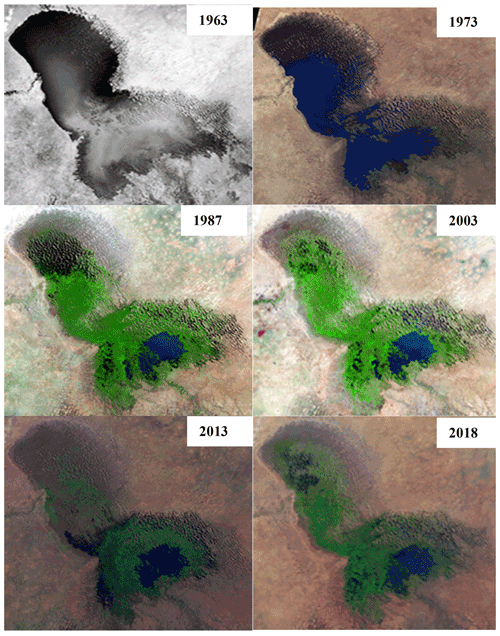Binh, P. D., Sylvestre, F., Papa, F., Frappart, F., Bouchez, C., and
Crétaux, J.-F.: The Lake Chad hydrology under current climate change,
Scientific Reports, 10, 5498,
https://doi.org/10.1038/s41598-020-62417-w, 2020.
Coastal SAF: Homepage, available at: http://www.coastal-saf.eu/, last access: 23 January 2021.
Coe, M. T. and Foley, J. A.: Human and natural impacts on the water resources of
the Lake Chad basin, J. Geophys. Res.-Atmos., 106, 3349–3356,
https://doi.org/10.1029/2000JD900587, 2001.
Elliott, M., Burdon, D., Atkins, J. P., Borja, A., Cormier, R., de Jonge, V. N.,
and Turner, R.: “And DPSIR Begat DAPSI(W)R(M)!” – A Unifying Framework for
Marine Environmental Management, Mar. Pollut. Bull., 118, 27–40,
https://doi.org/10.1016/j.marpolbul.2017.03.049, 2017.
Food and Agriculture Organization (FAO): Lake Chad Basin – Situation report July 2017, FAO – Food and Agriculture Organization of the United Nations, available at: https://www.fao.org/resilience/resources/resources-detail/en/c/1013218/ (last access: 21 October 2021), 2017.
Global Water Partnership (GWP): Transboundary Groundwater fact sheet, The Lake Chad Basin Aquifer System, Global Water Partnership, Global Secretariat, Sweden, 2013.
Hoegh-Guldberg, O., Jacob, D., Taylor, M., Bindi, M., Brown, S., Camilloni, I., Diedhiou, A., Djalante, R., Ebi, K. L., Engelbrecht, F., Guiot, J., Hijioka, Y., Mehrotra, S., Payne, A., Seneviratne, S. I., Thomas, A., Warren, R., and Zhou, G.: Impacts of 1.5 ∘C Global Warming on Natural and Human Systems, in: Global warming of 1.5 ∘C. An IPCC Special Report on the impacts of global warming of 1.5 ∘C above pre-industrial levels and related global greenhouse gas emission pathways, in the context of strengthening the global response to the threat of climate change, edited by: Masson-Delmotte, V., Zhai, P., Pörtner, H. O., Roberts, D., Skea, J., Shukla, P. R., Pirani, A., Moufouma-Okia, W., Péan, C., Pidcock, R., Connors, S., Matthews, J. B. R., Chen, Y., Zhou, X., Gomis, M. I., Lonnoy, E., Maycock, T., Tignor, M., and Waterfield, T., World Meteorological Organization Technical Document, Geneva, Switzerland, 2018.
Hutchinson, C. F., Warshall, P., Arnould, E. J., and Kindler, J.: Development in
Arid Lands Lessons from Lake Chad, Environ. Sci. Policy Sustain. Dev., 34,
16–43, https://doi.org/10.1080/00139157.1992.9931452, 1992.
International Conference on Lake Chad: Saving the Lake Chad to revitalize
the Basin's ecosystem for sustainable livelihood, security, and development,
available at: https://waterresources.gov.ng/lake-chad-conf/ (last access: 20 October 2021), 2018.
Lake Chad Basin Commission (LCBC): Report on the State of the Lake Chad Basin Ecosystem, GIZ Joint Report, Commission du Bassin du Lac Tchad (CBLT), Deutsche Gesellschaft für Internationale Zusammenarbeit (GIZ) GmbH, Bonn and Eschborn, Germany, 233 pp., 2016.
Lemoalle, J., Bader, J.-C., Leblanc, M., and Sedick, A.: Recent changes in Lake
Chad: observations, simulations and management options (1973–2011), Glob.
Planet. Change, 80–81, 247–254, https://doi.org/10.1016/j.gloplacha.2011.07.004, 2012.
Lemoalle, J. and Magrin, G.: Le développement du lac Tchad / Development
of Lake Chad: Situation actuelle et futurs possibles / Current Situation and
Possible Outcomes, Expertise collégiale, IRD Éditions, Marseille, France, 216 pp.,
2014.
Magrin, G.: The disappearance of Lake Chad: history of a myth, J. Polit.
Ecol., 23, 204–222, https://doi.org/10.2458/v23i1.20191, 2016.
Miletto, M., Caretta, M. A., Burchi, F. M., and Zanlucchi, G.: Migration and its interdependencies with water scarcity, gender, and youth employment, UNESCO Publishing, Paris, France, 34 pp., 2017.
Nagarajan, C., Pohl, B., Rüttinger, L., Sylvestre, F., Vivekananda, J.,
Wall, M., and Wolfmaier, S.: Climate-fragility profile: : Lake Chad basin, Adelphi research gemeinnützige GmbH, Berlin, Germany, 31 pp. 2018.
Newton, A. and Elliott, M.: A Typology of Stakeholders and Guidelines for
Engagement in Transdisciplinary, Participatory Processes, Front. Mar. Sci.,
3, 230, https://doi.org/10.3389/fmars.2016.00230, 2016.
Odada, E., Oyebande, L., and Oguntola, A. J.:. Lake Chad: experience and lessons
learned brief, Lake Environment Committee Foundation, Kusatsu, Japan, 18 pp., 2005.
Rashid, M., Shaofeng, J., and Zhu, W.: Analysis of climate variability, trends, and prediction in the most active parts of the Lake Chad basin, Africa, Scientific Reports, 9, 6317, https://doi.org/10.1038/s41598-019-42811-9, 2019.
Sayan, R. C. and Nagabhatla, N.: Soft Power, Discourse Coalitions, and the
Proposed Interbasin Water Transfer Between Lake Chad and the Congo River,
Water Altern., 13, 752–778, 2020.
United Nation Environment Programme (UNEP): Lake Chad Basin, edited by: Fortnam, M. P. and Oguntola, J. A., Global International Water Assessment (GIWA – Regional Assessment-43), University of Kalmar, Kalmar, Sweden, 2004.
United Nations (Department of Economic and Social Affairs): Population Division: World Population Prospects 2019 – Highlights, ST/ESA/SER.A/423, United Nation Publisher, New York, USA, 2019.
United States Geological Survey (USGS): Lake Chad, West Africa, Earth shots: Satellite Images of Environmental Change, available at: https://earthshots.usgs.gov/earthshots/Lake-Chad-West-Africa#ad-image, last access: 15 December 2020.
Vivekananda, J., Wall, M., Sylvestre, F., Nagarajan, C., and Brown, O.: Shoring up Stability; Addressing Climate and Fragility Risks in the Lake Chad Region, adelphi research gemeinnützige GmbH, Berlin, Germany, 101 pp., 2019.








